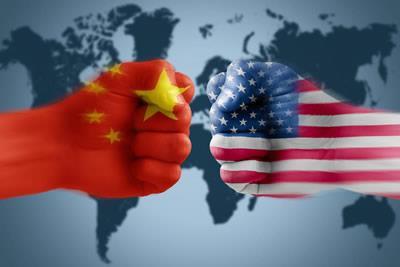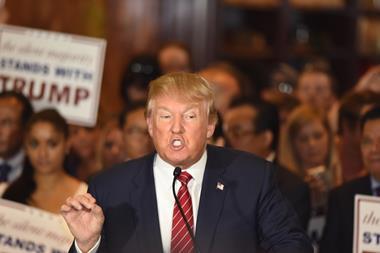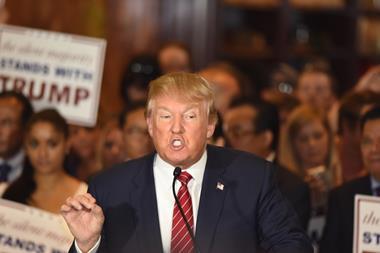Risk managers must prepare for an escalation in the trade war between the US and China and the implications it would have for business operations
Amid growing pressure on the global supply chain, experts are warning risk managers to plan for the escalation of the simmering US-China trade conflict.
Oxford Economics (OE) issued a new briefing which highlights the potential threat of an upsurge in the trade dispute between the two economic giants.

The report warned that November’s US presidential election could spark a rapid increase in the US-China trade war that has been running since 2018, especially if Donald Trump returns to the post.
It cites that early this year, former President Trump floated the possibility of imposing tariffs of 60% or more on Chinese goods, and also suggested a blanket 10% tariff on all US imports – possibly as a threat to try to persuade other countries to revalue their currencies – should he return to office.
In 2023, US import volumes from China were around 18% lower than in 2017. But the impact of tariffs on Chinese imports is bigger than that because in the intervening period, US demand grew substantially, which would typically lead to higher imports.
“New trade barriers have contributed to a significant reshuffling of the geographical trade patterns of the US and China,” the report said.
“The share of China in US imports has dropped by 7ppts, i.e. by a third, since 2018, with the biggest gainers in the US market being Mexico, Vietnam, Canada, Taiwan, and South Korea.
“Importantly, this has also happened in the electronics sector, which some observers at the start of the trade war thought might be resilient to the impact of US tariffs. In general, countries with similar export structures to China and competitive cost levels have gained the most from replacing imports of targeted goods from China.”
The study explained an important issue with respect to the reshuffling of trade patterns is the extent to which China has been able to circumvent US trade barriers by re-routing its exports.
Some observers have pointed to the fact that Chinese trade data suggest a rather smaller impact from US tariffs than the US data.
These commentators have argued either that China has been redirecting its goods to the US via third countries such as Vietnam, or that China has been sending its goods to the US in small packages that are exempt from tariffs and customs clearance processes – what is known as ‘de minimis’ imports.
“There is evidence of both happening, but estimates of the scale vary significantly,” OE added.
There are suggestions that as much as 16% of Vietnamese exports to the US in 2021 were re-routed products from China. But there are others which suggest this made up just 1.8% of Vietnamese exports.
One justification touted for US tariffs on China was to bear down on the US trade deficit.
“As we always suspected, this hasn’t happened – the US trade deficit has risen in dollar terms since 2018 and is basically unchanged as a share of GDP,” the study explained.
“However, there has been a big change in the geographical distribution of the deficit. The bilateral deficit with China has shrunk considerably to US$279 billion in 2023 from US$418 billion in 2018, whereas the bilateral deficits with Mexico, Canada, Vietnam, and other Asian economies have risen sharply. The deficit with the eurozone has been fairly steady.”
What does it mean for businesses?
OE added an important question for the years ahead is whether the US will be content with this pattern. “If the size of the overall trade deficit remains a concern, this would tend to encourage more protectionism,” it said.
“Moreover, the soaring bilateral deficits with places like Vietnam (over US$100 billion) and Mexico (over US$150 billion) may encourage restrictions against these economies. US trade policy risks falling into a ‘whack a mole’ routine, chasing soaring bilateral deficits from country to country.”
The research explained if one aim of US tariffs was to hobble China’s export growth in pursuit of strategic goals, then the policy has not worked so far.
US tariffs have had a clear negative impact on Chinese exports to the US – but overall Chinese export values have continued to grow at close to trend rates. This suggests China has been successful in re-orienting its exports to other destinations.
What’s next?
However, the OE warned that the situation is only likely to worsen.
“Our analysis suggests that the pattern of effects visible so far from the US-China trade war is unlikely to dissuade US policymakers from further protectionist actions or do much to prevent the bilateral US-China trade dispute from spilling over more to third countries,” it said.
“The economic costs to the US have been small and are unlikely to outweigh the perceived strategic and political gains from protection against China.
“Moreover, China’s continued strong export growth and the lack of impact of tariffs on the US trade deficit might encourage policies to hit China harder still and broaden protectionism to third countries.”
However it warned it would be wrong to assume that ramping up protectionism by the US can happen without significant economic costs.
So far, US trade measures against China have only raised the weighted US tariff level by a couple of percentage points. But the kind of tariff increases recently floated would be a huge escalation of protection.
“Tariffs of 60% on China plus 10% on other trade partners would – depending on their precise scope, such as applying to dutiable goods only or all goods and applying to all trade partners or excluding those with which the US has free trade agreements – imply a rise in the US weighted tariff of two to six times the rise seen so far, “ the study added. “In the worst case, the average tariff would head back to interwar levels.
“The GDP and price effects would be much bigger and spillovers to third economies would be likely to increase dramatically.
“China would need to be even more aggressive in pushing export goods onto other markets, with potentially dramatic impacts on trade patterns as, leading to protectionist backlashes there. And general US tariffs on non-China trade partners would almost certainly result in retaliation that would risk unwinding much of the trade liberalisation seen in the decades since WWII.”
Risk managers have been advised they need to factor in the potential for an escalation in the trade war and the implications it would have for their operations, be it costs of goods and materials or ease of access at a time when supply chains are already stressed.














No comments yet